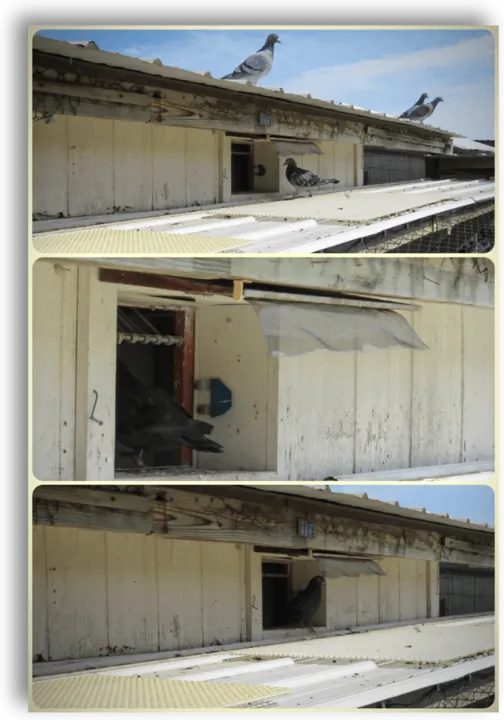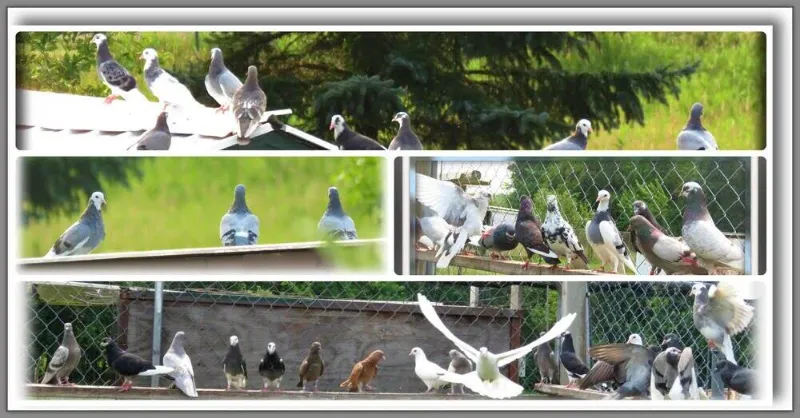From weaning to flying and everything in between. A basic overview of everything you need to know about getting your young kit up in the air, flying, and back down into the loft without losing any. Want to know how to settle older birds? Well, we cover that here too.
Weaning Babies From Their Parents … Introducing a New Home:
When young birds are able to eat and drink on their own, I wean them from their parents and move them into our flyer loft. At this point, I will leave them locked in the flyer loft for a day or two. This way, they all have time to get used to one another as they adjust to life without mom and dad while becoming familiar with their new home and surroundings. I give them constant food and water while keeping a close eye to ensure they’re all eating and drinking to get strong.
Putting Weaners Out in the Nursery Cage:
I pick each one up after a few days in the flyer loft, pushing them through the porthole out into the nursery cage I’ve set up on the loft roof. I will then close the porthole behind them, locking them out of the loft. This in turn gives them the opportunity to study and learn about their surroundings. Keep in mind that when I wean my young, they can’t fly yet. They will sit up there and flutter around, learning how to flap their wings. I will leave them out there for a few hours each day. I will then go back into the loft, open the porthole, shake food while whistling, and call them back through the porthole back inside the loft, closing the porthole. I now give them fresh water and fill their feeders with plenty of food, leaving their food until the evening. When evening rolls around, I’ll go back in the loft, pick up any leftover food, and then close them up for the night. By not feeding them again in the morning, I can ensure they will be getting hungry by mid-morning; at which time I will put them back out in the nursery cage for a few hours, training them to get fed by coming back through the porthole into the loft. This is now a rinse-and-repeat process for the next 3 days or so.
At this point, they’re starting to really learn the routine and how it works. With each passing day, they are getting bigger and stronger. Now the fun begins. On the 4th day, I remove the nursery cage from the roof and have it completely opened to the outside. On this 4th day, I do NOT pick them up and put them outside. On this day, I leave the porthole open and allow them to figure out how to go out on their own. Now they have the freedom to go in and out at will. On the 5th day, I will open the porthole, and any bird that does not go out on its own, I will then pick up and put it through the porthole on the roof. You will now see them sitting out there, walking around, and fluttering their wings. We really enjoy sitting out in lawn chairs and just watching them learn. Again, after a few hours, I will shake food, whistle, and call them back in and feed them. I will continue this process day after day after having removed the nursery cage. Keep in mind that at this point, they are starting to hover over the roof a bit and circle around. When they build their confidence, you will see them finally take flight and fly up into the air. Once they do this, they will keep doing it.

NOTE: I only put birds out when the weather is nice and sunny, not windy or rainy. Keep in mind this is brand new to them, and you want to prevent them from getting spooked. I also scour the skies to ensure there is nothing lurking about looking to hone in and steal one of my birds for a meal. I sit outside watching while I have them sitting out on the roof, knowing they are sitting ducks, should a hawk swoop in and scare them. At this point, the roller’s reaction would be to try and fly, and then, as they say, … the rest is history. You don’t want to lose them before you even get started flying them. (For more on hawk awareness and protecting your pigeons, see my article and video where I discuss this in detail.)

Also, I just wanted to mention that my roof is pole barn metal, which can get quite hot in the sun, so I actually have these sheets of thick plastic that are made up of really small squares. These sheets are roughly 2 inches thick and do not get hot at all. This way, when my birds are out on the roof, they are stepping on these sheets and not the hot pole barn metal, and their poop falls through the holes, so they are never sitting or standing in any poop. In my book, that’s a win-win situation.

Now The Fun Begins:
So, at this point, we’ve seen every bird on the roof or landing board take flight, on their own accord, and actually fly around in the sky before landing…So, what’s next? Well, it’s safe to say they are ready to start training.
The next day, I will start putting them all out an hour before I feed them each day. I will enter the loft, open the porthole, and put my arms out, guiding them through the porthole out onto the roof. I will then drop the dowels of the porthole down, so at this point, they will now have to push through dowels to come back in and will not be able to go back out after doing so. They are now learning how the dowels work. Once they are all out sitting on the roof, I will leave the loft, walk out in front, and throw my hat up in the air to scare them up into the air.
This trick teaches them to go up and fly all together, so they are now learning how to fly as a kit. After repeating this process over the next few days, they are learning that when I let them out, I want them to go up and fly. When I whistle and shake food, they learn I want them to come back down and go straight in. Roughly after a week goes by, I can now open the porthole, and they will naturally pour out and take flight all on their own as a kit. They will, in turn, begin to do the same thing, coming in on their own without my constant shaking of food. They see me with the bucket walking toward their loft, so they start coming down and head straight in to eat. Pigeons are extremely intelligent and quick learners.
My birds will usually fly steadily for at least an hour or so. They like to go up high, while I do have a few other kits that like to go really high, where it’s hard to see them. At any rate, either way, when they start to descend while still flying, then I know they are tired and want to come down and go in. I will go get their bucket of feed if I have not already done so to let them know they can go in.
Well, that’s training weaners in a nutshell. That’s as simple as it gets.

NOTE: It’s not good practice to let your birds out to fly, after which you let them meager around all day without calling them back in. I have mine go into the attached fly pen when they come in, so they are still able to be outside, but this way they are safe from trouble or lurking predators. As my dad would say, “If a pigeon is left to its own demise, you can be sure it will find its way into trouble.” Now you might be saying to yourself, you see my birds out sitting around in my pictures on my website. Yes, that is true in a sense, the fact is, I let them sit out for the sole purpose of taking those pictures so I had something to reference on my site. I was trying to get a nice variation of colors without having the fly pen fencing in the background.
That doesn’t mean you can’t let your bird hang out. But I highly suggest you be present when they are and vigilant to ensure their safety.
How to Settle and Fly Older Birds and Breeders:
So, you purchased one or more older rollers, and by older, I mean anything that is older than weaning age and trained to fly in a completely different location. So now what? Do you keep them prisoners for the rest of their lives and simply use them for breeding and let them out in your fly pen, or do you want to fly them? Well, if the answer is the ladder, then let’s get started…
You just bought some new birds and brought them home; now what? Well, depending on where you bought them, you might be best off quarantining them for a week or so before introducing them into your loft to ensure the safety of all your other birds. Depending on where it came from and who you bought it from, this may or may not be required. Look the birds over really well to see if there are any signs of any potential issues brewing. Put some newspaper down so you can see what the poop looks like. I can say with absolute certainty that any bird purchased through my loft would not need any kind of quarantine period. I say that because I know how diligent I am about the health of my birds and would never even ponder the thought of selling a bird if I thought for a second there was even the slightest chance there would be anything wrong with its health. I am not saying that to be arrogant in any way, I am just stating facts about my practices in my loft. Now, with that said, I can’t say the same for birds that are shipped from a distance. Now that will be the shipping providers’ responsibility—getting the bird(s) to its destination in a timely and well-cared-for manner. The conditions the bird undergoes during shipping will determine how healthy the bird is upon reaching its final destination.
Ok, done with all that? Now it’s time to introduce the bird(s) to their new home, your loft. At this point, you will need to keep these birds locked up in the loft and only allow them out into the fly pen for the next week or two. It is very important to have a good, spacious fly pen so they have the ability to look all around and really familiarize themselves with their new surroundings and get used to their new outside environment. You can also put a cage on the exterior of the loft outside the porthole, similar to what we do with our young weaned birds, so they really get used to the access to go in and out.
Ok, some time has passed; now it’s time to remove the cage and allow the new bird(s) to freely go in and out. The first time out without a cage must be on a clear day with little wind and on an empty stomach. Late morning is usually a good time if you don’t have a reoccurring hawk problem. Be sure the trap door is fully accessible so birds can freely go in and out during the first few outings. Whatever you do, DON’T chase them out the porthole the first few times. Let the birds get the lay of the land so they don’t fly away and never come back.
After that, they should behave similarly to all of your other birds that you are flying. Now you just need to get them out at the same time as your kit so they can learn to fly with the others.
IN CONCLUSION:
I hope this info helps you get some real enjoyment out of training and watching your birds take flight and fly. I tell ya what, if you are new to this sport or hobby, be warned, rollers can really become addicting as they have such fun little personalities, and just staring up in the sky waiting in anticipation to see who rolls first or how many times while they are in flight is pretty exciting, not to mention the sense of calm it brings you. That’s all for now; drop us a line if you have any questions.


